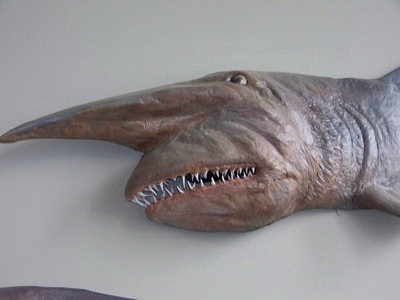Overview - Form may follow function, but it does
not always have to be pretty. While the goblin shark is well adapted for its deep-sea
habitat, some people have referred to this fish as “the ugliest living shark.”
Still others liken it to an alien from outer space. Its mostly pink body
contains soft, flabby flesh. Perhaps its most distinguishing feature is its
uniquely shaped head. The shark’s beak-like snout protrudes like a trowel,
making it perfect for investigating muddy ocean bottoms. When the goblin shark
retracts its jaws, the snout looks more like a really long, pink nose. Since
this shark frequents deep waters, sunshine does not provide much light at such
levels. The goblin shark, therefore, has very small eyes, and must often rely
on its other senses for detecting predators and prey, as well as for directing
movements.
Feeding Habits - The diet of goblin sharks consists of
crabs, deep sea fishes, shrimps and other organisms within its habitat, which
covers regions offJapan, Australia, Portugal and South Africa, as well as
portions of the Atlantic Ocean. Its teeth are shaped like long needles that the
shark can manipulate like a grasping claw. Locating meals may be tricky, but
once prey is detected, it stands little chance of escape as soon as the goblin
shark sinks in its teeth.
Cool Fact - The goblin shark’s scientific name
honors two men, Kakichi Mitsukuri and Alan Owston, who both helped with this
shark’s discovery at the end of the 19th century.
Depth - 4,265 feet.
February 9, 2007—A rare goblin shark—a "living
fossil" that closely resembles ancient shark species—was caught alive
recently in Tokyo Bay, only to die within days.
Officials from the Tokyo Sea Life Park
discovered the 4.3-foot-long (1.3-meter-long) creature on January 25 during an
expedition with local fishermen. The shark had been tangled in fishing nets 500
to 650 feet (150 to 200 meters) deep.
But the animal died on the morning of
January 27 after being put on display for the public.
Little is known about the mysterious
goblin shark, which normally stays near the bottom of the ocean.
"Dead goblin sharks are caught from
time to time, but it is rarely seen alive," a park official told the AFP
news agency. "We were able to document the way the shark swims. After it
died, we dissected the specimen for further studies."
But the unusual find is giving scientists
déjà vu.
Earlier this month another deep-sea
prehistoric shark had been found in Japan—a frilled shark spotted on January 21
that, like the goblin, died quickly in captivity.














No comments:
Post a Comment
Leave a comment :)